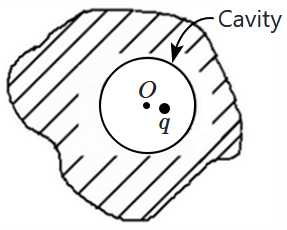
| 1. | zero |
| 2. | towards the centre |
| 3. | away from the centre |
| 4. | either towards or away from the centre depending on the sign of \(q\) |
Prefer Books for Question Practice? Get NEETprep's Unique MCQ Books with Online Audio/Video/Text Solutions via Telegram Bot
NEET MCQ Books for XIth & XIIth Physics, Chemistry & Biology| Statement I: | Gauss's law for electric fields is a consequence of the conservation of energy. |
| Statement II: | Coulomb's law for electric charges leads to a conservative electric field. |
| 1. | Statement I is incorrect and Statement II is correct. |
| 2. | Both Statement I and Statement II are correct. |
| 3. | Both Statement I and Statement II are incorrect. |
| 4. | Statement I is correct and Statement II is incorrect. |
Prefer Books for Question Practice? Get NEETprep's Unique MCQ Books with Online Audio/Video/Text Solutions via Telegram Bot
NEET MCQ Books for XIth & XIIth Physics, Chemistry & Biology1. \(R\)
2. \(R^{-3}\)
3. \(R^{-2}\)
4. \(R^{-1}\)
Prefer Books for Question Practice? Get NEETprep's Unique MCQ Books with Online Audio/Video/Text Solutions via Telegram Bot
NEET MCQ Books for XIth & XIIth Physics, Chemistry & BiologyA solid sphere carrying a uniformly distributed charge \(q\) within its volume rotates about a diameter \((d = 2r ).\) So that the speed on its equator is \(v.\) The electric field at the outer surface of the sphere is:
1. \(\dfrac{1}{4 \pi \varepsilon_{0}} \dfrac{q}{r^{2}}\)
2. \(\dfrac{1}{4 \pi \varepsilon_{0}} \dfrac{q}{3 r^{2}}\)
3. \(\dfrac{1}{4 \pi \varepsilon_{0}} \dfrac{q}{2 r^{2}}\)
4. \(\dfrac{1}{4 \pi \varepsilon_{0}} \dfrac{2q}{r^{2}}\)
Prefer Books for Question Practice? Get NEETprep's Unique MCQ Books with Online Audio/Video/Text Solutions via Telegram Bot
NEET MCQ Books for XIth & XIIth Physics, Chemistry & BiologyThen,
| 1. | \(q,Q\) are of the same sign and \(|q|=|Q|\) |
| 2. | \(q,Q\) are of opposite signs and \(|q|=|Q|\) |
| 3. | \(q,Q\) are of the same sign and \(|q|<|Q|\) |
| 4. | \(q,Q\) are of opposite signs and \(|q|>|Q|\) |
Prefer Books for Question Practice? Get NEETprep's Unique MCQ Books with Online Audio/Video/Text Solutions via Telegram Bot
NEET MCQ Books for XIth & XIIth Physics, Chemistry & Biology
| 1. | \(\dfrac{q}{\varepsilon_0}\) | 2. | \(\dfrac{q}{2\varepsilon_0}\) |
| 3. | \(\dfrac{2q}{\varepsilon_0}\) | 4. | \(0\) |
Prefer Books for Question Practice? Get NEETprep's Unique MCQ Books with Online Audio/Video/Text Solutions via Telegram Bot
NEET MCQ Books for XIth & XIIth Physics, Chemistry & Biology
1. \(\phi_t<\phi_c<\phi_b\)
2. \(\phi_t<\phi_b<\phi_c\)
3. \(\phi_t>\phi_c>\phi_b\)
4. \(\phi_t>\phi_b>\phi_c\)
Prefer Books for Question Practice? Get NEETprep's Unique MCQ Books with Online Audio/Video/Text Solutions via Telegram Bot
NEET MCQ Books for XIth & XIIth Physics, Chemistry & Biology| 1. | \(\dfrac{q}{\varepsilon_0}\) | 2. | \(\dfrac{q}{2\varepsilon_0}\) |
| 3. | \(\dfrac{q}{4\varepsilon_0}\) | 4. | \(\dfrac{q}{8\varepsilon_0}\) |
Prefer Books for Question Practice? Get NEETprep's Unique MCQ Books with Online Audio/Video/Text Solutions via Telegram Bot
NEET MCQ Books for XIth & XIIth Physics, Chemistry & Biology